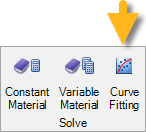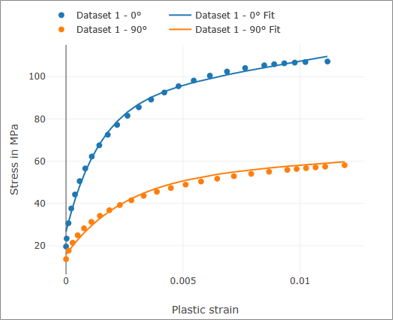Material Designer employs a phenomenological model to predict the nonlinear deformation behavior of short fiber composites. In fact, it combines an orientation dependent anisotropic Hill yield criterion with a nonlinear isotropic hardening law. See the theory section in the Material Designer User’s Guide, Hill Plasticity Curve Fitting for Short Fiber Reinforced Composites.
The parameters entering this constitutive model must be fitted against experimental uniaxial tensile data of the composite as described earlier in Experimental Data.
Use the following procedure to calibrate the plasticity model of a short fiber composite (assuming you already defined a Variable Analysis to compute linear elastic properties):
Enter the uniaxial test data for the 0° and 90° specimens as described in Experimental Data.
In Material Designer, add a Curve Fitting analysis from the Ribbon Bar.

In the Hill Plasticity Curve Fitting Tool Options, select the Dataset(s) of interest. As necessary, review and modify the remaining settings. You will find further details in the Material Designer User's Guide, Setting Up the Curve Fitting Analysis.
When the fitting is completed, you can assess the fit quality with the Stress-Strain Chart as well as review the computed material properties in the Results panel.

When exported to the Engineering Data, the material properties computed by the Curve Fitting Tool (Hill Yield and Isotropic Hardening) are combined with those from the Variable Analysis.

As a beta feature in Release 2021 R2, Material Designer can also estimate anisotropic, orientation tensor dependent ultimate stress limits. For more information about using this feature, visit the Ansys Help website and click the link to the Composites documentation.


